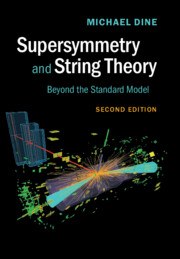Book contents
- Frontmatter
- Dedication
- Contents
- Preface to the First Edition
- Preface to the Second Edition
- A note on the choice of metric
- Text website
- Part 1 Effective field theory: the StandardModel, supersymmetry, unification
- Part 2 Supersymmetry
- Part 3 String theory
- 20 Introduction
- 21 The bosonic string
- 22 The superstring
- 23 The heterotic string
- 24 Effective actions in ten dimensions
- 25 Compactification of string theory I. Tori and orbifolds
- 26 Compactification of string theory II. Calabi–Yau compactifications
- 27 Dynamics of string theory at weak coupling
- 28 Beyond weak coupling: non-perturbative string theory
- 29 Large and warped extra dimensions
- 30 The landscape: a challenge to the naturalness principle
- 31 Coda: Where are we heading?
- Part 4 Appendices
- References
- Index
30 - The landscape: a challenge to the naturalness principle
from Part 3 - String theory
- Frontmatter
- Dedication
- Contents
- Preface to the First Edition
- Preface to the Second Edition
- A note on the choice of metric
- Text website
- Part 1 Effective field theory: the StandardModel, supersymmetry, unification
- Part 2 Supersymmetry
- Part 3 String theory
- 20 Introduction
- 21 The bosonic string
- 22 The superstring
- 23 The heterotic string
- 24 Effective actions in ten dimensions
- 25 Compactification of string theory I. Tori and orbifolds
- 26 Compactification of string theory II. Calabi–Yau compactifications
- 27 Dynamics of string theory at weak coupling
- 28 Beyond weak coupling: non-perturbative string theory
- 29 Large and warped extra dimensions
- 30 The landscape: a challenge to the naturalness principle
- 31 Coda: Where are we heading?
- Part 4 Appendices
- References
- Index
Summary
We have focused in this text on several questions of naturalness, and have used them to motivate searches for possible new physics. It is fair to say that most physicists find this principle compelling and are reluctant to accept extreme (or even modest!) fine tunings in theories of natural phenomena. But, during the past decade, a plausible, if highly speculative, alternative picture has gained currency, known as the landscape. If correct it provides a picture for the emergence of the laws of nature in which fine tunings are not surprising and provide few or no clues as to new degrees of freedom that might lie at higher energy scales.
We will divide our discussion into two parts. First we will explain, in very general terms, what is meant by a landscape and how it might address some naturalness problems in our current understanding of particle physics. Then we consider models for how a landscape might arise in string theory. These models are at best plausible; the existence of any nonsupersymmetric states in string theory (apart, possibly, from certain special AdS vacua), much less vast numbers of them, is hardly established.
The cosmological constant revisited
We have stressed that the cosmological constant (i.e. the dark energy) presents potentially the most striking failure of naturalness. One might hope to solve this problem by introducing new degrees of freedom. Supersymmetry helps to some extent. In global supersymmetry the ground state energy is well defined and of order the scale of supersymmetry breaking raised to the fourth power. In local supersymmetry there is also the term -3|W|2 in the potential. The problem is that this last term must very nearly cancel the positive contributions from supersymmetry breaking. The superpotential W can naturally be small as a result of R symmetries, but no one has proposed a mechanism, based on either dynamics or symmetries, which would lock W onto its required value. Many physicists have searched for an analog of the axion solution of the strong CP problem, in which some light field would adjust in such a way as to cancel the c.c. Without reviewing the various proposals, one might expect that the basic obstacle is in fact illustrated by the Peccei– Quinn mechanism.
- Type
- Chapter
- Information
- Supersymmetry and String TheoryBeyond the Standard Model, pp. 437 - 443Publisher: Cambridge University PressPrint publication year: 2016



